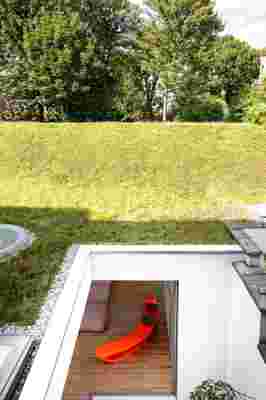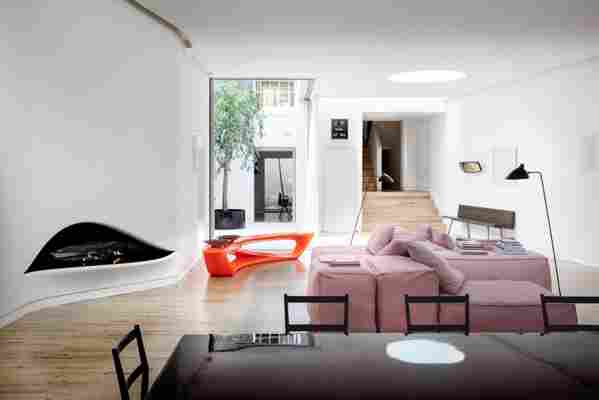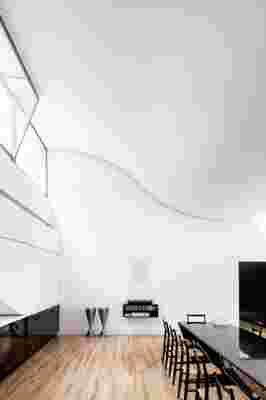To be sure, most of the people who walk by the fluorescent-orange number 5 at the front of Ben Evans’s traditional-looking terraced house in London don’t realize there is an architectural gem concealed within. “The home’s kind of central feature, in a way, is its secretness,” says the cofounder of the 16-year-old London Design Festival and executive director of the newer London Design Biennale, during which 40 countries, cities, and territories present design installations according on a common theme. “On the street you’ve got no idea what you’re walking into.”
Once a guest enters, however, it’s as if a whole new universe—shapely, bright, and carefully styled, if somewhat sparse—comes into focus. Evans continues: “There’s a very, very English expression, which unless you watched a children’s program called Doctor Who you wouldn’t understand: TARDIS-like . Doctor Who had this TARDIS, or time machine, and the concept was the inside was bigger than the outside. When you talked about hidden or surprising spaces, you would describe it as TARDIS-like, and that’s exactly what our house is, because it looks like a regular terraced house, but it’s a significantly bigger house that’s quite hard to conceptualize when you first walk in.”
Playing off the TARDIS reference, it’s a visionary, futuristic-tinged concept masterminded by Stirling Prize–winning architect Amanda Levete, formerly of the firm Future Systems and now principal of AL_A. The innovative Jane Drew Prize–winning talent happens to be Evans’s wife. Together for 12 years now, they each came into the relationship with a home. “It was about us doing a house together,” says Evans, who with Levete had quite a time of finding a place to build in Central London—a “nearly impossible” task. Eventually they discovered a traditional terraced house with a warehouse at the back, which they totally gutted and demolished, respectively.

The green roof of the house uses a Dutch system called sedum , and gets seasonal flowers in the spring and goes autumnal in the fall. “We felt this was a softer and user-friendly finish on the roof,” Evans says. Looking down inside the house is an orange bench designed by Levete in her signature fluorescent orange, commissioned by Established & Sons, with a pair of ceramic bowls bought in Marrakech that attracted the couple with their diverse black geometric patterns.
“It was a peculiar arrangement where it was like she was the architect and I was the client,” says Evans of their design and build process, which took two years. “We both enjoy a project, and she brought her ideas to show me and I thought they were wonderful. It was pretty easy.” The resulting five-bedroom, three-bathroom home features an expansive green roof and graceful double-wave ceiling that arcs over a capacious room acting as its soul. Evans contributed ideas about how they’d live in and use the space, which Levete translated into architecture.
The concept comprises a massive double-height "coming-together space" of 2,000 square feet, with Evans’s and Levete’s living quarters off it and an entire upper floor—including a second kitchen—for the couple’s four at-the-time teenage kids, totaling another 2,000. “That made it a very harmonious living experience, so they could be noisy and loud and it didn’t bother us,” he laughs. Dinner parties happen in that voluminous main room, with a high-sheen Levete-designed fiberglass dining table (with Gio Ponti Superleggera chairs) that seats up to 20. Unsurprisingly, they innovated with other materials, too, such as their master bath clad entirely in pale blue Corian, with a bathtub and elongated teardrop-shaped sink also in the thermoformable material.
“We furnished it quite minimally; we don’t want too much furniture. I think often you go into rooms and there’s too much stuff there,” says Evans. Most of the furnishings are bespoke, while others were collected during global travels. And though the couple were quite purposeful with the design, they happily took their time with interiors. The home has evolved a bit over the eight years they’ve been in it. They swapped out, for example, ply and black steel dining chairs for Gio Ponto Superleggera wicker-base chairs after being inspired by seeing the designer’s work at a hotel south of Naples, Italy, and added a pair of leather chairs of impeccable quality shipped home from a design fair in Buenos Aires, Argentina. “The main structure is there, but there are some subtle changes to the living experience. It’s quite refreshing,” Evans says. Highly personal design touches and objects, spare as they may seem, keep it endlessly interesting. He adds, “I think it’s very easy to have a space like that and have it feel a bit cold, and that’s not the feeling here.”
London Design Festival runs from September 15 through 23; London Design Biennale runs from September 4 through 23.


RELATED: High Above the Seine, a Paris Aerie with a Cache of Masterworks
